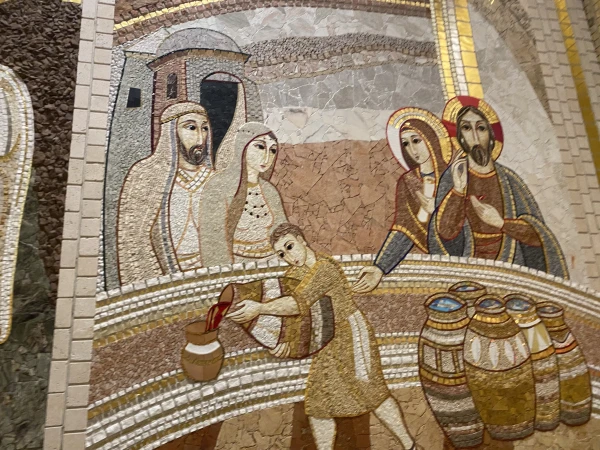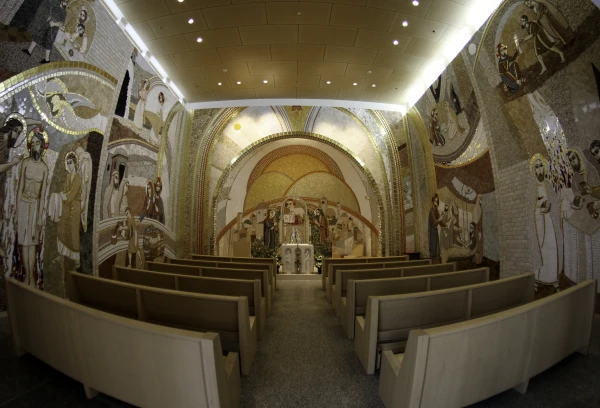Washington, D.C. Newsroom, Mar 6, 2024 / 07:00 am
In light of several serious accusations of abuse against Catholic artist Father Marko Rupnik, the Knights of Columbus told CNA that they “are carefully considering the best course of action” concerning the priest’s mosaics that adorn the St. John Paul II National Shrine in Washington, D.C.
With the assistance of the Congregation of the Sisters of Our Lady of Mercy and a small, lay staff, the Knights of Columbus own and operate the St. John Paul II National Shrine, which attracts tens of thousands of visitors and pilgrims from across the country and world.
Calls to remove the priest’s artwork from places of worship have been mounting around the world. Yet, extensive Rupnik artwork in the John Paul II Shrine’s two chapels remains in place.
CNA emailed the Knights of Columbus about the Rupnik mosaics. In response, the order signaled that it may be open to removing the mosaics from the shrine but did not give any indication for when a decision will be made.
“We are carefully considering the best course of action concerning the art that was installed by the Centro Aletti community here at the shrine,” the Knights responded.
“The shrine remains committed to carrying out its mission of evangelization through the teachings of St. John Paul II, to which instances of abuse are antithetical,” the email said, adding that they “are disturbed by these latest developments and continue to pray for those harmed by instances of abuse.”
The order purchased the John Paul II Cultural Center from the Archdiocese of Detroit in 2011 and it was designated a national shrine by the U.S. Conference of Catholic Bishops in 2014.
The Knights of Columbus declined CNA’s request for clarification.

Who is Marko Rupnik?
Ordained a priest in 1985, Rupnik has been a prolific artist in the Church over the last several decades, with his work prominently featured in such sites as the shrine in Lourdes, the Vatican’s Redemptoris Mater Chapel, and the St. John Paul II National Shrine.
Yet, his legacy and art are now marred by accusations of physical and psychological abuse of numerous religious sisters and his expulsion from the Jesuits.
As recently as Feb. 21, two former sisters of the now-dissolved Loyola Community in Slovenia accused Rupnik of subjecting them to spiritual, psychological, and sexual abuse.
His many once widely lauded works of art, characterized by bold, colorful mosaics with large, flowing figures and enormous eyes, are now proving a problem for the shrines and churches that they adorn.
‘His art now profanes the sacred spaces’
Anne Barrett Doyle, co-director of a group that keeps an online database of clergy abuse, sharply criticized the John Paul II Shrine for not having removed the Rupnik mosaics, claiming that it signals that the Church’s “commitment to healing victims is shallow.”
(Story continues below)
“His art now profanes the sacred spaces that it inhabits,” she told CNA.
Doyle, who has met and spoken with some of Rupnik’s alleged victims, said that “he sometimes used his victims as his models for some of his pieces” and that “his art and theology and his sexual predations were all intertwined.”
She believes the only ones who should get to decide the future of Rupnik’s art are his victims.
While some claim that removing Rupnik’s art would necessitate the removal of any religious art by artists who lived sinful lives, Doyle said that this is a “bogus argument.”
“We’re talking about a living perpetrator with many living victims,” she said. “Who among us is going to be able to pray and contemplate God in a place with a Rupnik mosaic on the wall? That has now become an impossibility for anyone who’s followed this case at all.”
“Seeing the art of a predator in a sacred place is a terrible insult to our faith. But the worst insult is to his victims and the effrontery to them is unforgivable,” she explained, adding that “those places of worship need to be restored to the sacred, and that can only happen if his art is removed.”

More critics call for removal
Tim Law, co-founder of the group Ending Clergy Abuse, told CNA that the fact that there has been no public plan announced to remove Rupnik’s mosaics from the St. John Paul II National Shrine is “inconceivable” and sends a “horrific message” to the American faithful.
Law claimed that the Church’s handling of Rupnik’s case signals that a culture of cover-ups “continues to be intact.”
Father Paul Hedman, a priest in the Archdiocese of St. Paul-Minneapolis who runs a Catholic website called Canon Law Ninja, has also been advocating for the mosaics’ removal on social media.
Hedman told CNA that the mosaics are “inherently connected to abuse” and that Rupnik’s victims “should not have to face the art of their abuser if they wish to visit such places as Lourdes [and] the JPII Shrine.”
“It leaves a path for re-traumatization of victims,” he said. “Additionally, survivors who were abused in a Church context, even if not by Rupnik, may also feel retraumatized to be subjected to a known abuser’s art.”
“Refusal to take down the art and continuing to actively use it in various publications, as the Vatican has, also gives the impression that the Church doesn’t take abuse seriously,” Hedman said.
Fate of Rupnik’s art remains uncertain
Approaching the Sanctuary of Our Lady of Lourdes with its soaring spires, it is hard to miss the 21st-century addition by Rupnik’s Centro Aletti to the facade of the lower basilica.
After forming a special commission last year to determine the future of the Rupnik mosaics at the Lourdes shrine, Bishop Jean-Marc Micas of Tarbes and Lourdes told CNA that he hopes to make a decision by this spring.
Micas said that this is a “very, very difficult decision to make” and that “this occupies my mind, my prayer, and my heart every day, especially when I meet victims of abuse.”
In the U.S., the question continues to go largely unaddressed, with the mosaics at the John Paul II Shrine remaining thus far untouched.
Staff at the John Paul II National Shrine did not reply to multiple CNA requests for comment.






